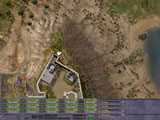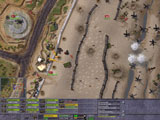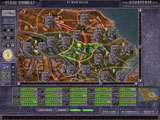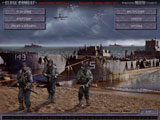 My favorite wargames of the last year have
been Big Time Software’s revolutionary Combat
Mission (which finally brought 3D to World War II tactical gaming) and
Talonsoft’s Rising Sun, which revitalized an old
engine by moving it to a new setting. Both of these games took some chances. Nobody at Big
Time was sure that anyone would be interested in the game (and thus their surprise when
their first run sold out in less than a week). Talonsoft also bucked all conventional
wisdom (everyone knows that the WWII Pacific Theatre is commercial death) by producing the
superb Rising Sun. Thus my disappointment with Close Combat—Invasion: Normandy.
I’ve played every one of the Close Combat games, and my attitude towards them has
deteriorated as the series has progressed. Though initially revolutionary, the Close
Combat series has gradually lost its edge,
and has lately settled for introducing a few new features and tweaks with each new
edition. Some of these—the addition of a strategic game, leadership rules, off-board
artillery, ambush mode, and improved graphics—have improved gameplay and addressed
some of the complaints of the game’s fans. But other problems never quite got
resolved—enemy AI, especially vehicle AI--remained problematic, and the game’s
top-down 2D view remained less than optimal for determining line of sight. More damning,
the Close Combat series insisted upon revisiting pretty much the same territory each
time—World War II on the Western Front. The one sally into foreign territory—the
East Front, in the series’ problematic third iteration—could have been a great
game had it focused on the Stalingrad Rattenkrieg. Instead, it attempted to cover the
entire Russian Front and foundered due to lack of focus and an overemphasis on armored
combat. Though fans have been asking for a change in locale—say the Pacific Theatre,
or even the Western Desert—Invasion Normandy not only revisits the Western Front, it
even covers the same campaign as the first game—only from the Utah Beach side. If you
want more of the same, it’s here in spades. My favorite wargames of the last year have
been Big Time Software’s revolutionary Combat
Mission (which finally brought 3D to World War II tactical gaming) and
Talonsoft’s Rising Sun, which revitalized an old
engine by moving it to a new setting. Both of these games took some chances. Nobody at Big
Time was sure that anyone would be interested in the game (and thus their surprise when
their first run sold out in less than a week). Talonsoft also bucked all conventional
wisdom (everyone knows that the WWII Pacific Theatre is commercial death) by producing the
superb Rising Sun. Thus my disappointment with Close Combat—Invasion: Normandy.
I’ve played every one of the Close Combat games, and my attitude towards them has
deteriorated as the series has progressed. Though initially revolutionary, the Close
Combat series has gradually lost its edge,
and has lately settled for introducing a few new features and tweaks with each new
edition. Some of these—the addition of a strategic game, leadership rules, off-board
artillery, ambush mode, and improved graphics—have improved gameplay and addressed
some of the complaints of the game’s fans. But other problems never quite got
resolved—enemy AI, especially vehicle AI--remained problematic, and the game’s
top-down 2D view remained less than optimal for determining line of sight. More damning,
the Close Combat series insisted upon revisiting pretty much the same territory each
time—World War II on the Western Front. The one sally into foreign territory—the
East Front, in the series’ problematic third iteration—could have been a great
game had it focused on the Stalingrad Rattenkrieg. Instead, it attempted to cover the
entire Russian Front and foundered due to lack of focus and an overemphasis on armored
combat. Though fans have been asking for a change in locale—say the Pacific Theatre,
or even the Western Desert—Invasion Normandy not only revisits the Western Front, it
even covers the same campaign as the first game—only from the Utah Beach side. If you
want more of the same, it’s here in spades.  That’s not to say there aren’t a few of the usual
tweaks to the game engine—it’s just that they seem much fewer and less
significant than previous ones. Probably the most important change is the addition of a
“force pool.” In the series’ previous strategic games, you were pretty much
stuck with whatever troops the scenario gave you. In Invasion: Normandy, you’re given
a force pool to draw from. You can use it to reinforce depleted units, replace destroyed
ones, or just change your force composition. The
game also includes new terrain, in particular the landing beaches at Utah. That’s not to say there aren’t a few of the usual
tweaks to the game engine—it’s just that they seem much fewer and less
significant than previous ones. Probably the most important change is the addition of a
“force pool.” In the series’ previous strategic games, you were pretty much
stuck with whatever troops the scenario gave you. In Invasion: Normandy, you’re given
a force pool to draw from. You can use it to reinforce depleted units, replace destroyed
ones, or just change your force composition. The
game also includes new terrain, in particular the landing beaches at Utah.
 But oddly enough, the landing scenarios
don’t have much of a “Saving Private Ryan” feel to them. It’s true
that the Utah landings were not nearly as strongly opposed as those at Omaha, but an
opposed amphibious landing is still a different tactical animal than assaulting a village.
You’d never know it from playing Invasion: Normandy. It’s much the same with the
game’s representation of the airborne landings. In games like Shrapnel’s 101,
you got a feel for how lost and desperate the scattered airborne units were during the
first days of the campaign. Not only are the
airborne landings themselves not represented in Invasion: Normandy, but when you do take
control of airborne units behind enemy lines they’re presented as remarkably coherent
groups of light infantry rather than patchwork groups of tough but confused survivors. In
other words, the two most dramatic moments of this campaign—the amphibious and
airborne landings—are completely drained of personality. It’s depressing. But oddly enough, the landing scenarios
don’t have much of a “Saving Private Ryan” feel to them. It’s true
that the Utah landings were not nearly as strongly opposed as those at Omaha, but an
opposed amphibious landing is still a different tactical animal than assaulting a village.
You’d never know it from playing Invasion: Normandy. It’s much the same with the
game’s representation of the airborne landings. In games like Shrapnel’s 101,
you got a feel for how lost and desperate the scattered airborne units were during the
first days of the campaign. Not only are the
airborne landings themselves not represented in Invasion: Normandy, but when you do take
control of airborne units behind enemy lines they’re presented as remarkably coherent
groups of light infantry rather than patchwork groups of tough but confused survivors. In
other words, the two most dramatic moments of this campaign—the amphibious and
airborne landings—are completely drained of personality. It’s depressing.
Even more depressing is the fact that
the enemy AI remains stupid. Enemy units are hopeless on the attack, and it seems beyond
them to organize an effective defense. Generally, there’s too much of tendency for
enemy units to attack and defend piecemeal, and tanks still have a difficult time
negotiating a maneuver of any complexity. If you want a tough game, you’ll have to
play online—by far the best way to play Invasion: Normandy—or crank the
enemy’s strength way up.
 Look, I’ve been an advocate of this game series for a long
time, but I’m over it now. While Close
Combat: Invasion Normandy is by no means a bad game, it’s a game I’ve played one
too many times. If you’re a big fan of the series and you can’t get enough of
hedgerows, by all means buy the game. But I’m tired of the same old engine covering
the same old material. Frankly, while playing Close Combat—Invasion: Normandy all I
could think about was how much I’d rather be playing Combat Mission. Which I think
I’ll now do. Look, I’ve been an advocate of this game series for a long
time, but I’m over it now. While Close
Combat: Invasion Normandy is by no means a bad game, it’s a game I’ve played one
too many times. If you’re a big fan of the series and you can’t get enough of
hedgerows, by all means buy the game. But I’m tired of the same old engine covering
the same old material. Frankly, while playing Close Combat—Invasion: Normandy all I
could think about was how much I’d rather be playing Combat Mission. Which I think
I’ll now do.
--Rick
Fehrenbacher |

 My favorite wargames of the last year have
been Big Time Software’s revolutionary Combat
Mission (which finally brought 3D to World War II tactical gaming) and
Talonsoft’s Rising Sun, which revitalized an old
engine by moving it to a new setting. Both of these games took some chances. Nobody at Big
Time was sure that anyone would be interested in the game (and thus their surprise when
their first run sold out in less than a week). Talonsoft also bucked all conventional
wisdom (everyone knows that the WWII Pacific Theatre is commercial death) by producing the
superb Rising Sun. Thus my disappointment with Close Combat—Invasion: Normandy.
I’ve played every one of the Close Combat games, and my attitude towards them has
deteriorated as the series has progressed. Though initially revolutionary, the Close
Combat series has gradually lost its edge,
and has lately settled for introducing a few new features and tweaks with each new
edition. Some of these—the addition of a strategic game, leadership rules, off-board
artillery, ambush mode, and improved graphics—have improved gameplay and addressed
some of the complaints of the game’s fans. But other problems never quite got
resolved—enemy AI, especially vehicle AI--remained problematic, and the game’s
top-down 2D view remained less than optimal for determining line of sight. More damning,
the Close Combat series insisted upon revisiting pretty much the same territory each
time—World War II on the Western Front. The one sally into foreign territory—the
East Front, in the series’ problematic third iteration—could have been a great
game had it focused on the Stalingrad Rattenkrieg. Instead, it attempted to cover the
entire Russian Front and foundered due to lack of focus and an overemphasis on armored
combat. Though fans have been asking for a change in locale—say the Pacific Theatre,
or even the Western Desert—Invasion Normandy not only revisits the Western Front, it
even covers the same campaign as the first game—only from the Utah Beach side. If you
want more of the same, it’s here in spades.
My favorite wargames of the last year have
been Big Time Software’s revolutionary Combat
Mission (which finally brought 3D to World War II tactical gaming) and
Talonsoft’s Rising Sun, which revitalized an old
engine by moving it to a new setting. Both of these games took some chances. Nobody at Big
Time was sure that anyone would be interested in the game (and thus their surprise when
their first run sold out in less than a week). Talonsoft also bucked all conventional
wisdom (everyone knows that the WWII Pacific Theatre is commercial death) by producing the
superb Rising Sun. Thus my disappointment with Close Combat—Invasion: Normandy.
I’ve played every one of the Close Combat games, and my attitude towards them has
deteriorated as the series has progressed. Though initially revolutionary, the Close
Combat series has gradually lost its edge,
and has lately settled for introducing a few new features and tweaks with each new
edition. Some of these—the addition of a strategic game, leadership rules, off-board
artillery, ambush mode, and improved graphics—have improved gameplay and addressed
some of the complaints of the game’s fans. But other problems never quite got
resolved—enemy AI, especially vehicle AI--remained problematic, and the game’s
top-down 2D view remained less than optimal for determining line of sight. More damning,
the Close Combat series insisted upon revisiting pretty much the same territory each
time—World War II on the Western Front. The one sally into foreign territory—the
East Front, in the series’ problematic third iteration—could have been a great
game had it focused on the Stalingrad Rattenkrieg. Instead, it attempted to cover the
entire Russian Front and foundered due to lack of focus and an overemphasis on armored
combat. Though fans have been asking for a change in locale—say the Pacific Theatre,
or even the Western Desert—Invasion Normandy not only revisits the Western Front, it
even covers the same campaign as the first game—only from the Utah Beach side. If you
want more of the same, it’s here in spades.